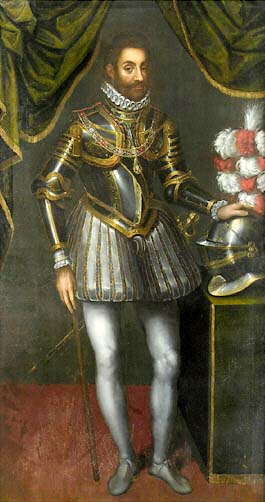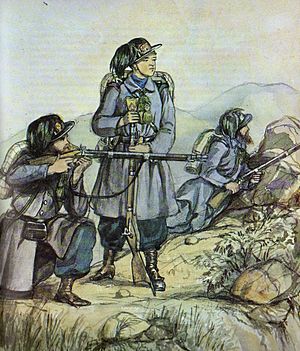Royal Sardinian Army facts for kids
Quick facts for kids Royal Sardinian Army |
|
|---|---|

Flag of the Royal Sardinian Army
|
|
| Active | 1414–1861 |
| Country | |
| Branch | Army |
| Type | Army |
| Role | Defense of the interior and borders of the Kingdom of Sardinia's continental portion (Piedmont, Liguria, Savoy and the Aosta Valley) |
| Size | 79,000 (in 1859) |
| Engagements | War of the Mantuan Succession Nine Years' War War of the Spanish Succession War of the Polish Succession War of the Austrian Succession First Italian War of Independence Crimean War Second Italian War of Independence |
The Royal Sardinian Army was the army of the Duchy of Savoy and later the Kingdom of Sardinia. It was active from 1416 until May 4, 1861. After this date, it became part of the Royal Italian Army.
People usually call it the "Savoyard Army" when the rulers were Dukes. They call it the "Sardinian Army" after 1720, when the rulers became Kings of Sardinia.
Contents
History of the Army
How the Army Started

The Savoyard Army officially began in the 1400s. At first, local lords kept soldiers in areas like Piedmont and the Aosta Valley. They managed these soldiers for the Duke.
Duke Emmanuel Philibert made big changes in 1566. He took control of the army from the local lords. He also created a "peasant militia," which was an army made of ordinary people. Back then, soldiers often stayed in the army for a very long time. Training was not very good, which made the army less effective.
Changes in the 1600s and 1700s
In the 1600s, the army of Piedmont changed a lot. Before this, it was a mix of soldiers hired by the Duke, paid fighters, and Protestant groups. In 1664, the Duke created his own regiments. These units carried the Duke's coat of arms as their flag.
Seven years later, in 1671, the army got uniforms. Most units wore light grey, similar to the French army. The Piedmontese army was always open to new ideas. It kept modernizing, especially under Victor Amadeus II.
Two important changes happened in 1685. The army created special grenadiers (soldiers who threw bombs). They also stopped using pikemen (soldiers with long spears). Other European armies, like the French and Spanish, made these changes much later.
In 1709, new rules for fighting were introduced. These rules were inspired by the Prussian army and the English and Dutch forces. Soldiers learned to fire their guns in groups called platoons. This made their firing more steady and powerful. This system was used for many years.
The army grew bigger throughout the 1700s. In 1691, it had 12 infantry regiments, 3 dragoon regiments, and 2 cavalry regiments. By 1747, it had over 32 infantry regiments. In 1774, the army had about 100,000 soldiers. The king controlled the troops, helped by experienced generals. Most officers were from noble families.
The 1800s and Unification

After 1796, the Sardinian Army was slowly broken up. It became part of the forces under Napoleon.
When the kingdom was restored in 1815, Victor Emmanuel I rebuilt the army. It had ten infantry brigades, plus cavalry and artillery.
Under Victor Emmanuel II, the Royal Sardinian Army improved a lot. It grew in size and quality. In 1858, a new military law was made. It set military service at five years of active duty, followed by six years in the reserve. Soldiers also had to do 50 days of training each year.
The army had two types of service: ordinanza and provinciale. Ordinanza included special units like the Royal carabinieri and volunteers. Provinciale was for all other soldiers.
Certain people were not allowed to join the army. This included criminals and judges.
At this time, the Piedmontese army had about 79,000 men. This included officers and regular soldiers. There were also about 20,000 volunteers from other areas, like the Hunters of the Alps. Many soldiers were farmers or laborers. Only a small number could read and write. The army had schools to teach soldiers these skills.
After the unification of Italy, the Sardinian army became the Royal Italian Army.
How the Army Was Organized
In the early 1800s, most Sardinian soldiers were farmers (65%) or laborers (25%). Only 10% were from richer families. About 20% could read and write. Soldiers earned a small pay, plus food and wood. Their families also received some support.
Infantry

The infantry was the main part of the Sardinian army. It had different types of units:
- National Service Infantry: These were soldiers from the Duchy of Savoy. They were easy to use within the territory. In peacetime, there were about 20,000 of them. In war, this could grow to 50,000.
- Royal Light Legion: This special group started in 1774. They were border guards who stopped smuggling. Most of them were foreigners. This helped prevent them from showing favoritism to local people. This group later became the modern Guardia di Finanza in Italy.
- Foreign Service Infantry: These were volunteers from neighboring countries like France and Switzerland.
- Provincial Infantry: This group started in the 1600s. Soldiers served for a fixed time, usually 20 years.
- Free Corps: These units were named after their commanders. They were common in many armies during the 1700s.
- Territorial Militia: These were local volunteers. They mostly served in mountain areas like the Alps. They guarded villages and helped the regular army by scouting.
To make the infantry better, there were training camps. These were like those in France and Germany. The most important camp was in Briga Alta.
Cavalry
The Sardinian cavalry was known for being brave in battle. It was made up entirely of soldiers from Savoy. In peacetime, they had 2,420 horsemen. This number could double in wartime.
The cavalry included:
- 3 groups of bodyguards for the king.
- 6 regular regiments, like the famous "Piemonte Reale Cavalleria" and "Savoia Cavalleria". These regiments continued to exist in the Kingdom of Italy.
In 1852, the cavalry was reorganized:
- 4 dragoon regiments: "Nizza Cavalleria," "Piemonte Reale Cavalleria," "Savoia Cavalleria," "Genova Cavalleria."
- 5 chevau-léger regiments: "Cavalleggeri di Novara," "Cavalleggeri di Aosta," "Cavalleggeri di Saluzzo," "Cavalleggeri di Monferrato," "Cavalleggeri di Alessandria."
- 1 guide squadron: "Squadrone Guide."
Each regiment had a staff, 4–6 active squadrons, and 1 reserve squadron. A squadron had officers, junior officers, trumpeters, blacksmiths, saddlers, and about 130 soldiers with 100 horses.
Artillery
The Sardinian artillery was like the French artillery. It was organized into brigades. Each brigade had 4 to 6 cannons. About 300 horses moved these cannons. Soldiers assembled them on the battlefield.
Artillery was divided into field artillery, mountain artillery, and siege artillery (like mortars and howitzers). Many artillery soldiers came from Biella. This was also where the cannons were made. In battle, each infantry brigade got five cannons, and each cavalry brigade got four.
Specialists
The military engineers were based at Casale Monferrato. They had two battalions, each with five companies. These companies had officers, junior officers, trumpeters, and 88 men.
Engineers were assigned to different army divisions. They built things like telegraph lines. Civilian companies also helped with their work.
Weapons and Gear
Infantry soldiers carried rifles with bayonets and daggers. They also had a bandolier to hold rifle ammunition. Officers did not carry guns; they only had close-combat weapons.
New rifles were adopted in 1844. They started using percussion rifles, which were more modern. By 1859, all rifles used an "Eggs" capsule for firing. All rifles had bayonets that could be attached without blocking the gun.
The musket also changed. New models appeared in 1833. They were made shorter and lighter in 1844, like infantry rifles.
The carbine was mainly given to sharpshooters. It was also the special weapon of the carabinieri.
Pistols were first widely used in the Sardinian army in 1847. There was a large cavalry pistol, but it was not very good. Pistol bullets were round and hollow.
From the 1700s, cavalry soldiers used carbines. These were accurate for short distances. Most horses were bay-colored and came from Germany. They served for 4–6 years. In the 1800s, the carabinieri became the main cavalry force. They were famous for their brave sword charges in the First Italian War of Independence. Dragoons used long rifles with bayonets, but they also kept their sabres.
The typical artillery cannon was the mod.704 rear-load saker. This cannon was used until 1848. Heavy artillery had long cannons.
Officers in the Army
Junior Officers
Junior officers were usually chosen from ordinary soldiers. They were picked based on their skills and how well they performed. Some were trained in army schools. Others went to special schools for their specific army branch. Soldiers who left the Austrian army and joined the Sardinian army often kept their old rank.
Senior Officers
A law about officers was approved in 1852 by Victor Emmanuel II. Like junior officers, officers who left the Austrian army and joined the Sardinian army kept their rank.
Here is how officers were promoted:
- Sub-lieutenants: One-third came from junior officers. Two-thirds came from military academies.
- Lieutenants: In peacetime, they were promoted based on how long they had served. In wartime, one-third could be chosen freely.
- Captains: In peacetime, one-third were chosen freely. In wartime, half were chosen freely.
- Majors: In peacetime, half were chosen freely. In wartime, all were chosen freely.
- Lieutenant-Colonel and above: All promotions were chosen freely, in both peace and war.
Officer Ranks
| Sleeve insignia |  |
 |
 |
 |
| Rank | Sergente maggiore | Sergente | Caporale maggiore | Caporale |
| English | Sergeant major | Sergeant | Corporal major | Corporal |
See also
 In Spanish: Ejército Sardo para niños
In Spanish: Ejército Sardo para niños
- Kingdom of Sardinia
- Royal Sardinian Navy
- Uniforms of the Italian Armed Forces










